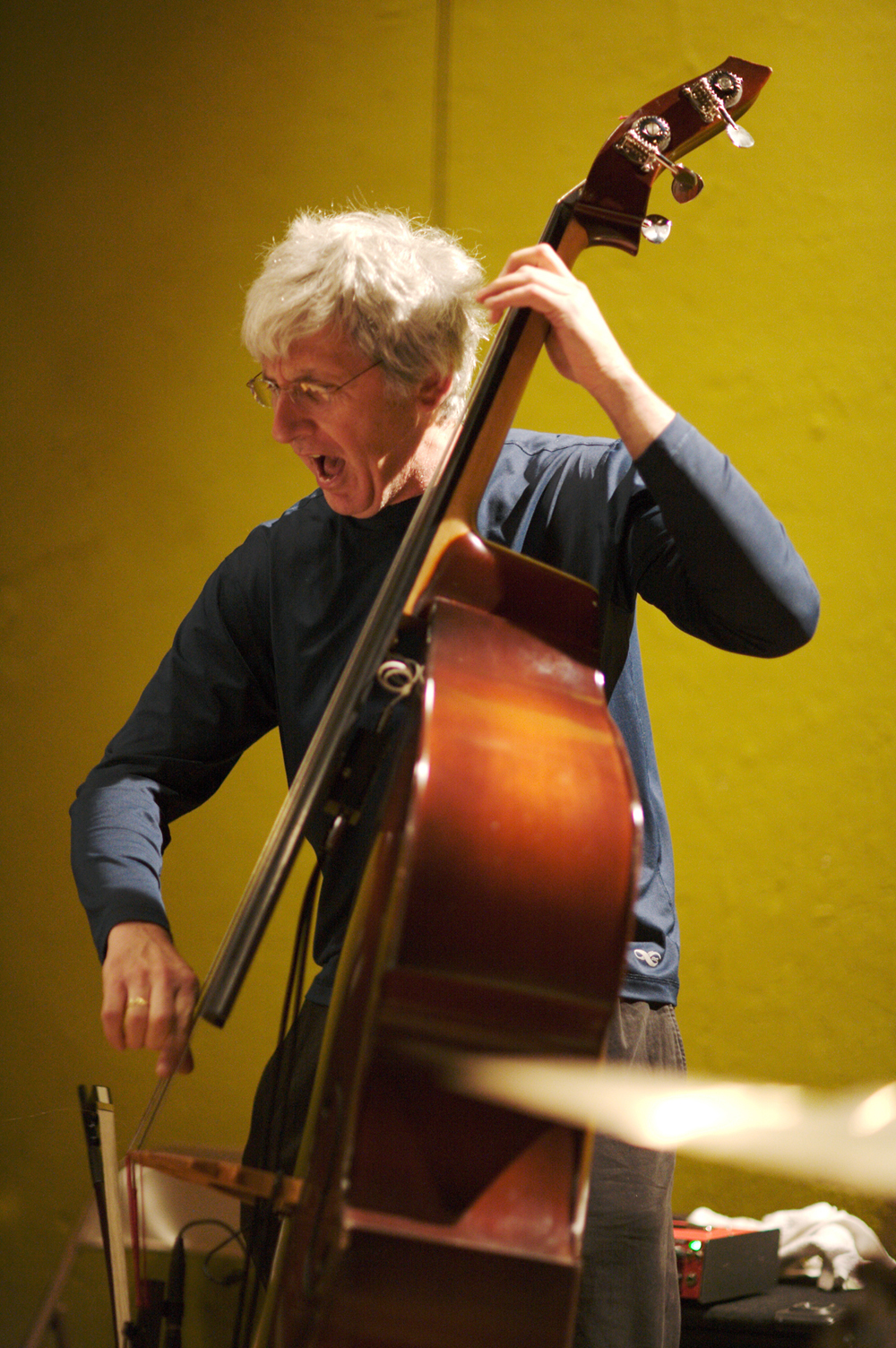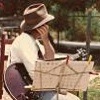Home » Jazz Articles » Live Review » Mark Dresser, Matthias Ziegler and Denman Maroney: San D...
Mark Dresser, Matthias Ziegler and Denman Maroney: San Diego, February 4, 2011

Conrad Prebys Concert Hall, UCSD
San Diego, CA
February 4, 2011
Dresser, Maroney and Ziegler have a wealth of performing experience as a unit, although surprisingly, this was their first performance together since 2003. Held in the acoustically superb Conrad Prebys Concert Hall, this reunion (which brought Denman Maroney from New York and Matthias Ziegler from Switzerland) was first class all the way.
The roots of the Mark Dresser Trio run deep. Dresser's relationship with "hyper-pianist" Maroney dates back to 1989, when the two first gigged as a duet in an improvised set at the Museum of Modern Art's PS1 in New York. He began including Maroney in virtually every group he assembled from that point on and later met Ziegler in Switzerland during a tour of his Arcado String Trio. Ziegler, who is the principal flautist with the Zurich Chamber Orchestra and has toured with ECM recording artist Pierre Favre, has roots in both the traditional flute repertoire and in improvised music.
Their first performance as a trio happened in 2000, and continued often throughout 2003 as they developed their near telepathic approach to music making, the unifying force at work being Dresser's original compositions which negotiate the passages between written and improvised material so seamlessly that it's difficult to distinguish one from the other.
What unites this group and makes them so distinct a unit is their mutual approach to tone and timbre manipulation, and their commitment to the art of metric modulation. Dresser and company treat rhythm as an extrapolation of an idea he first experienced listening to Charles Mingus: that of slowing the time down or speeding it up within the standard song form. It's a way of dealing with poly-rhythms and metric subdivisions that creates the illusion of going faster or slower. You don't need to be a math major or even an expert in music to take this all in. The beauty of Dresser's music is how accessible it is, despite it's complex nature.
On the issue of timbre manipulation—it would be hard to find a group more experienced in this regard. Maroney calls his concept, which found him playing the inside of the instrument as much as the keyboard, "hyper-piano." His role in the trio might also be referred to as "sound-generator." Maroney used several objects stored inside the concert grand to facilitate his expressions: a heavy copper bar; a solid, chrome-plated steel cylinder; varied pieces of plastic. With these simple items, he transformed the piano into a machine capable of producing almost any sound imaginable. He slid the copper bar across the strings to achieve an effect like the bowing of zithers; other times he guided the cylinder along a string, or strings, for a startling "slide-piano" sound.
Ziegler played the piccolo and conventional flutes with the casual expertise expected; however his bass flute and huge contrabass flutes were outfitted with internal pickups to maximize the reverberant effects of guiding air down their large chambers. Sometimes the pickups were put into action to amplify the percussive sounds of pad- popping with minimal air flow.
Contrabassist Dresser also had several specialized pickups installed underneath the fingerboard of his instrument at locations chosen to amplify the soft overtones available. Although all three musicians utilize pickups and amplification, there was no other signal processing used during the concert. These devices were used simply to magnify the subtle sounds that were always there, but not normally audible.
The concert began with "FLBP" which stands for flute-bass-piano. This was the first composition Dresser wrote for the trio many years back. Maroney caressed the strings inside his piano with the copper bar, getting some weird electronic sounds and delay- type effects that would be astonishing from a bank of synthesizers, let alone from an acoustic instrument. Ziegler breathed soft columns of air into the huge contrabass flute, (it's taller than he is), to get a sound like a giant blowing into an underground tunnel. Dresser occasionally activated the overtone pickups to amplify ghostly harmonics and the strange clicking sounds of his wedding ring tapping on the strings. Then he moved into high arco work—as in violin range—to begin the melody, which featured a hiccupping effect with the bow. Maroney again exploited the zither-like capabilities of the hyper-piano, while Ziegler switched to flute, picking up the melody where Dresser left it. Even sitting in the first row, staring intently at the musicians, didn't guarantee an accurate assessment of who was playing what.
The trio began a long improvised introduction into Dresser's "Rasa" (For sitarist Kartik Seshadri). Dresser, in one swift bowing maneuver, shifted from "G" on his low "E" string to a piercing high note at the edge of human hearing. When the trio began the yearning, stair-step melody, Maroney (switching to "regular" piano), Ziegler and Dresser coaxed it out of the ether—in perfect unison. "Rasa" was an instant highlight of the concert.
The trio then tore into Dresser's "metric-modulated" blues piece, "Digestivo." After working though the complex theme, Dresser guided the proceedings with his sped up, slowed down "walking" bass lines, while Ziegler's piccolo bent bluesy phrases and sent others into the stratosphere. Maroney played the piano conventionally as he demonstrated a crystalline, lyrical side to his playing. Out of nowhere, Ziegler and Dresser dropped out, and Maroney launched into a forceful, totally authentic stretch of pure stride piano! Dresser's solo concentrated on the big meaty notes in the lower register before reaching for thumb-position punctuation.
The final performance of the first set was a medley of three Dresser originals: "Threaded / Aquifer / Flac." Ziegler returned to the contrabass flute, but mostly concentrated on high overtones in the flute range, made more resonant by the size of his woodwind. Dresser began bowing a melody, then shifted into a hunt for harmonics everywhere on his bass. Maroney slid the steel cylinder along one string, achieving eerie, outer space effects and taking full advantage of the huge, reverberant chamber of the grand piano's "box." At one point Dresser became so involved with slapping his "E" string, it actually broke! Fortunately the medley was winding to it's conclusion, and the bassist carried on, as if nothing was wrong.
During a short intermission, Dresser set about replacing the string and the trio returned to accompany a 16 minute film by noted multimedia artist Tom Leeser. Ziegler popped the pads on his contrabass flute like a set of tuned drums, Maroney spun lyric lines with his right hand, while muting strings with his left. Meanwhile, the bass bowed strong, dark themes underneath Ziegler's approximation of a deity blowing kisses into a cavern.
They carried on with Dresser's ballad , "Telemotions," Ziegler concentrating on the bass flute and Maroney opening his bag of tricks, and coaxed a sound like a de-tuned dulcimer cruising interstellar space. The concert came to an end with Dresser's homage to the late drummer Ed Thigpen, "Modern Pine." The melody demonstrated a plaintive, yet celebratory spirit, and once again there was the bassist's unique approach to "walking," which was akin to a New Orleans second line after plenty of drinks.
This was a strange and beautiful concert, performed with a telepathic lockstep by three masters of multiple disciplines. Their total immersion into timbre manipulation and metric modulation was a perfect example of how high, and deep, creative music can get.
Photo Credit
Courtesy of Cryptogramophone
< Previous
Essential CTI: Part 3
Next >
Odysseys
Comments
About Mark Dresser
Instrument: Bass, acoustic
Related Articles | Concerts | Albums | Photos | Similar ToTags
Mark Dresser
Live Reviews
Robert Bush
United States
Denman Maroney
Pierre Favre
Charles Mingus
Ed Thigpen
For the Love of Jazz
 All About Jazz has been a pillar of jazz since 1995, championing it as an art form and, more importantly, supporting the musicians who create it. Our enduring commitment has made "AAJ" one of the most culturally important websites of its kind, read by hundreds of thousands of fans, musicians and industry figures every month.
All About Jazz has been a pillar of jazz since 1995, championing it as an art form and, more importantly, supporting the musicians who create it. Our enduring commitment has made "AAJ" one of the most culturally important websites of its kind, read by hundreds of thousands of fans, musicians and industry figures every month.























